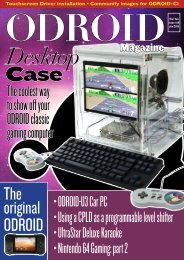Lamp
ODROID-Magazine-201509
ODROID-Magazine-201509
- No tags were found...
Create successful ePaper yourself
Turn your PDF publications into a flip-book with our unique Google optimized e-Paper software.
XU4 ANDROID CLOUDSHELL GAMING<br />
XU4 CLUSTER<br />
SLAY THE DRAGON,<br />
save THE VILLAGE<br />
sword of xolan proves<br />
that no matter how high def<br />
our displays get,<br />
we will always<br />
love pixels<br />
by Bruno Doiche<br />
One of my all time favourite<br />
games ever<br />
was an arcade game<br />
called Black Tiger, a classic<br />
Capcom platformer that<br />
blended adventure with<br />
some RPG elements, where you would look for coins<br />
in order to get better items and progress in the game. I<br />
love to emulate it whenever I can, and couldn’t be happier<br />
to stumble across this gem from a Turkish indie<br />
game developer that managed to capture the thrill that<br />
I felt when first playing it. It comes with the added<br />
bonus of having excellent controller support!<br />
https://play.google.com/store/apps/details?id=com.<br />
Alper.SwordOfXolan&hl=en<br />
Platforming, check. Runs on all ODROIDs, check. Controller<br />
support, check. Awesome swashbuckling fun, check!<br />
CUDA-aware MPI programs. The only missing requirement<br />
was OpenCL. The Jetson TK1 doesn’t support OpenCL even<br />
though the Nvidia Tegra K1 SoC does.<br />
To evaluate both CUDA and OpenCL on an MPI cluster,<br />
I would need to get into custom boards based on the Tegra K1<br />
SoC. Alternatively, I could bring up a second cluster for evaluating<br />
OpenCL with MPI and leave the evaluation of CUDA and<br />
MPI to the Jetson TK1 cluster. Right about that time, I saw the<br />
news announcing the ODROID-XU4 at about half the price of<br />
the ODROID-XU3, Jetson TK1, and Arndale Octa. That’s how<br />
I ended up with a five-node cluster of four ODROID-XU4s and<br />
one ODROID-XU3, which is working well so far.<br />
Final setup<br />
Bringing up the cluster of four ODROID-XU4 boards was fairly<br />
straight forward. I ordered the boards from www.ameriDroid.<br />
com and some aluminum standoffs from www.pololu.com. Both<br />
vendors delivered the components extremely fast, and everything<br />
worked right out of the box. I didn’t have to return any boards at<br />
all, which was a relief and a timesaver. I stacked the boards with<br />
1.25” 4-40 thread M-F standoffs, using 0.25” standoffs for the bottom<br />
of stack, and fastening the stack with 5/16” screws.<br />
The XU4 boards share two ASUS VX238H HDMI monitors<br />
and two pairs of USB keyboards and mice, alongside one<br />
ODROID-XU3 and a cluster of Nvidia Jetson TK1 boards<br />
through two Bytecc 4-port USB HDMI KVM switches, which<br />
came with USB+HDMI cables and convenient infrared remote<br />
controls. I purchased a powered USB hub in order to supply<br />
power to one of the keyboards, a Corsair K70 gaming keyboard<br />
with lights, without which my Microsoft mouse wouldn’t work<br />
when connected to XU4 USB 2.0 port through a USB switch.<br />
I initially tried using Bytecc 5-Port HDMI switches for sharing<br />
the monitors while using separate USB switches for the mice<br />
and keyboards. The caveat was that neither ASUS VX238H nor<br />
Samsung SyncMaster BX2431 HDMI monitors were detected<br />
correctly. So, I ditched that switching scheme in favor of using<br />
Bytecc 4-port USB HDMI KVM switches.<br />
I flashed the Ubuntu 15.04 image for XU3/XU4 boards<br />
onto four 16GB Patriot microSD UHS-1 cards which I inserted<br />
into microSD slot on XU4 boards. With the boot mode switch<br />
set to boot from microSD, three boards came up to Ubuntu<br />
MATE desktop. The fourth board also booted properly after I<br />
replaced its Patriot microSD card with a fifth card. I confirmed<br />
that all 8 cores were in use by Ubuntu in HMP mode.<br />
Fans often turn on and off randomly, generating some noise<br />
during operation. After shutting down Ubuntu and turning the<br />
A/C power off, the red LED stays on, although unplugging the<br />
HDMI cable turns the red LED off. The cluster is connected<br />
through a NETGEAR GS-116 16-port Gigabit Ethernet switch.<br />
I used a simple MPI program with MPICH to verify operation<br />
of XU4 and XU3 as a cluster. Everything is working well so far.<br />
ODROID MAGAZINE 18



